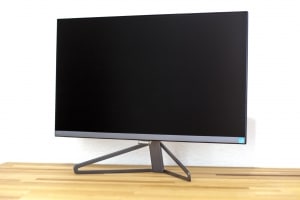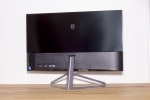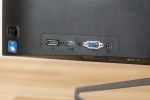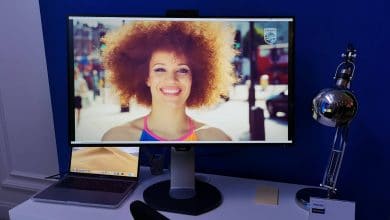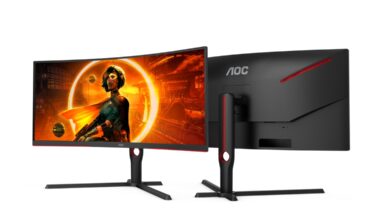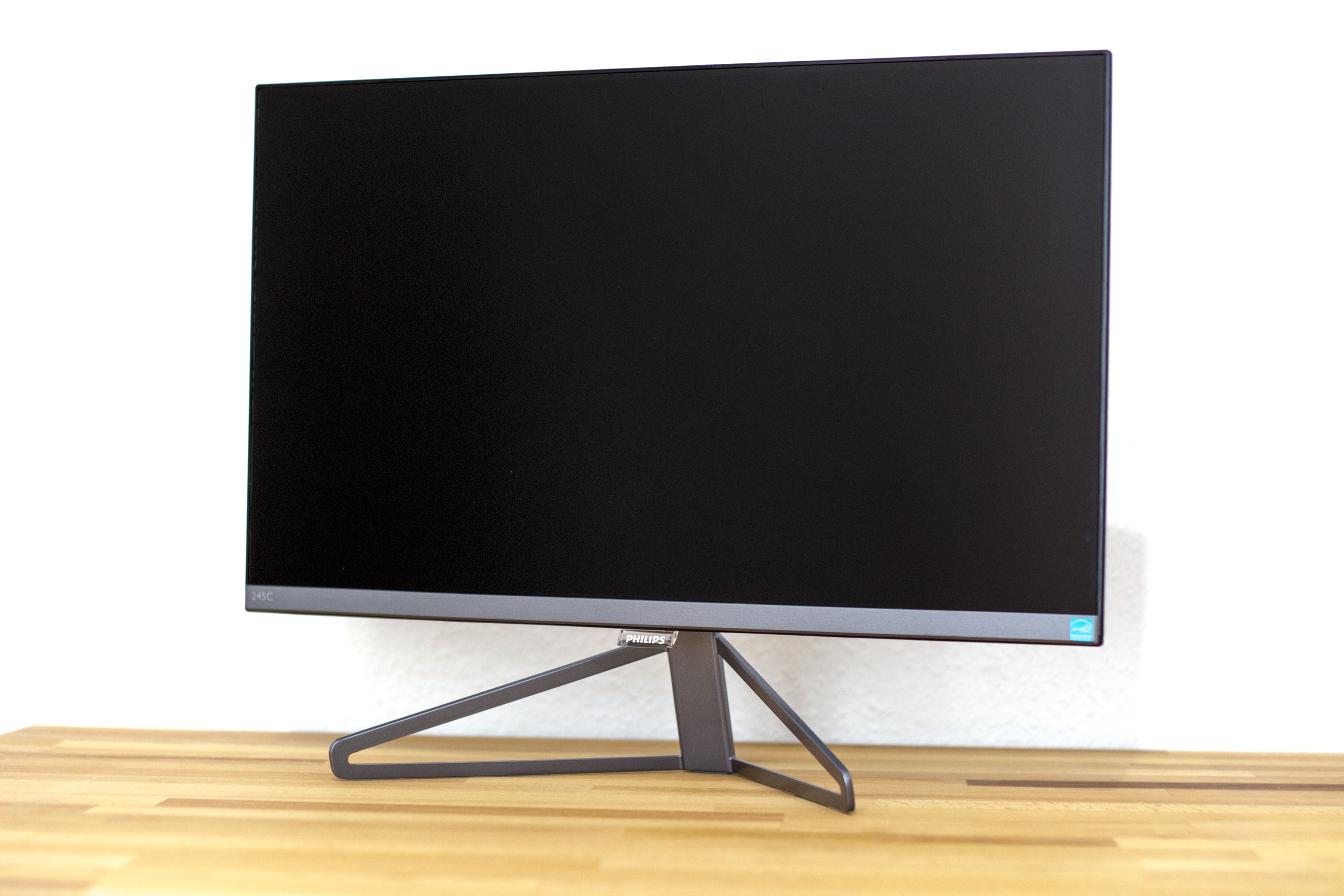
With its Moda series, Philips puts a special focus on the design of the monitor. This one comes in a very slim design. The upper part of the Philipps 245C7QJSB reaches a depth of only 5.2 millimeters. The monitor is equipped with Ultra Wide Color technology. Thanks to this the higher colour range is possible.
Characteristic for this noble device is the low depth and the narrow bezels of the display edges as well as the unusual stand base. We could not see any practical benefit from the shallow depth. Because the display is much thicker in the lower part. A large part of the space is required by the stand itself. Due to the missing VESA device, it cannot be replaced.
Specifications of the Philips 245C7QJSB
| Modelname: | Philips 235C7QJSB |
| LCD Panel | IPS |
| Resolution | 1900 x 1080 (60 Hertz) |
| Backlight | W-LED flicker-free |
| Diagonal | 23.8 inch |
| Ergonomics | Tiltable Display (-5°, +20°) |
| Colour space | NTSC: 101.4 % (CIE1976) / 90 % (CIE1931), sRGB: 122.7 % |
| color depth | 8 bit – 16.7 million colors |
| Brightness, maximum | 250 cd/m2 |
| Contrast | 1000 : 1 |
| Power consumption | Operation: 13.65 W; Standby: 0.3 W |
| Reaction time | 5 ms – grey-to-grey |
| aspect ratio | 16:9 |
| Audio | Headphone output |
| Viewing angle (vertical, horizontal) | 178°, 178° |
| Video inputs | DisplayPort 1.2; HDMI 1.4; VGA |
The Philips monitor comes with a user documentation, the required cables and the stand.
Design of the Philips 245C7QSJB
The Philips monitor comes in a simple yet elegant design. The border is kept in black, only the lower performance appears in silver. On the silver bar appears the model name 245C of the monitor. On three sides the outer edge is limited to 2.5 mm. The almost frameless design allows you to concentrate on the data displayed even better than with conventional screens. Films, for example, can be enjoyed really well with this monitor without disturbing edges.
In addition, the 24SC7QJSB is perfect for using multiple monitors side by side at the same time. The connectors are located on the back of the display. For a secure stand, Philips also supplies the matching stand in a noble silver look.
Ultra Wide Color
Once called UltraColor, the new Ultra Wide Color technology hides an extension of the color range. Phosphorus layers are used for this purpose. These extend the colour spectrum of the W-LED blacklights, which extend the spectrum of the conventional W-LED backlights. Philips promises 101.4% of the NTSC color space in the 245C7QJSB. According to the manufacturer’s data sheet, NTSC is covered up to 90 % according to CIE1931. Thus, the sRGB color space is significantly exceeded with 122.7 %.
Philips 245C7QJSB with little equipment
Apart from the high colour range and the noble design, the Philipps colour monitor does not require any special equipment. The IPS panel resolves with 1920 x 1080 pixels at 60 Hz.
DisplayPort and HDMI are each available once. These are complemented by VGA (D-Sub) and an additional headphone output. The monitor can only be adjusted in the angle of inclination. It can neither be adjusted in height nor is there a pivot. In addition, the 245C7QJSB lacks USB ports. On the other hand, the low power consumption of around 13.7 watts, which corresponds to energy efficiency class A+, can be regarded as positive.
Features of the Philips 245C7QSJB monitor
Equipped with an IPS panel that covers more than 100% of the sRGB color spectrum, the 245C7QSJB is the perfect monitor for photographers and designers alike. However, not only designers will be enthusiastic about the outstanding image quality. Even the typical user will be able to enjoy the extremely slim display due to the multitude of practical features.
Both vertically and horizontally, the IPS panel provides a clear viewing angle of 178 degrees. Thanks to the fast response time, which is just 5 ms, even fast moving objects can be easily detected.
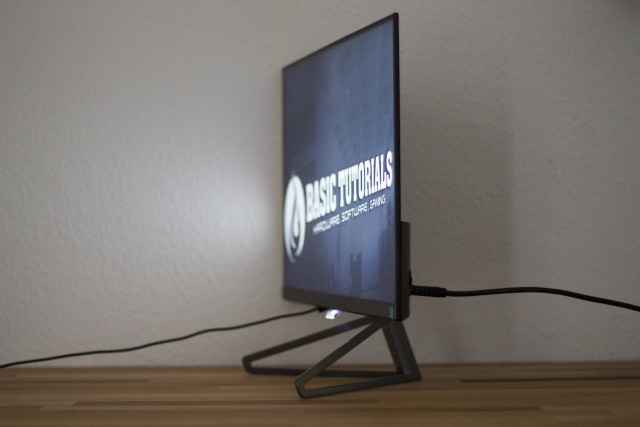
We were enthusiastic about the SmartImage. This handy feature allows you to switch between multiple pre-calibrated presets on the display. Included in these presets are
- Economy
- Film
- Photo
- LowBlue Mode
- Office
- game
- Text.
If you define one of these presettings, the calibrated settings of the SmartKolor and SmartContrast functions are used. You can also modify both in the OSD settings according to your individual needs.
The advantage of the SmartContrast function is the analysis of the displayed content. Use this feature to adjust the intensity of contrast and backlighting accordingly. In contrast, the SmartKolor function increases color saturation and expands the visual color range. Thanks to these functions you can, for example, achieve perfect contrast for good image quality while simultaneously saving energy in Economy Mode.
In LowBlue mode, on the other hand, the amount of damaging blue lights is reduced. These allow you to work several hours fatigue-free along the flicker-free display, watching movies or playing games.
Connections
On the back of the monitor you will find the OSD joystick. With this you can easily navigate through the OSD menu. If you hold the joystick for three seconds and press “Press” at the same time, the screen turns off. If you are not in the OSD menu, you can use the joystick as an ideal shortcut to
- to switch between the SmartImage image defaults
- to make changes to the volume of the speaker
- change the input selection.
The OSD menu contains all standard image settings such as
- five different gamma modes
- brightness
- sharpness
- Contrast
- Toggle between 4:3 image formats and widescreen
- Select between two different temperature modes 9300 K and 6500 K.
You can also make changes to the SmartContrast, SmartKolor and SmartTxt functions. You can also configure the color levels of the blue, green and red colors and select four different speeds for the reaction time.
The joystick is also used in Samsung monitors, for example. In my opinion it is much better suited for operation than the usual touch controls.
Conclusion on the Philips 245C7QJSB
The Philips 245C7QJSB is ideal for everyday work, professional use and games. It is the ideal choice if you value slim design and extreme colour accuracy. The SmartImage presets are also worth seeing. In addition to the elegant design, the display scores with a multitude of additional features.
Ultra Wide Color’s wide colour gamut gives a more natural appearance to greens and makes blues and reds look more vibrant. The IPS panel supports viewing angles up to 178 degrees. The screen is equipped with D-Sub, HDMI and a DisplayPort connection.
However, the Philips 245C7QJSB leaves much to be desired in terms of ergonomics. The display can only be tilted backwards by 20 degrees and forwards by 5 degrees. Nevertheless, the slim monitor convinced us, especially as the current price of approx. 219 Euros is a good price-performance ratio.
Pro
- Almost frameless monitor
- flicker-free
- ultra-wide color palette
- SmartImage
- numerous features
Contra
- Little equipment
- not much Ergonomics
- no USB ports available
Philips 245C7QJSB
Design
Equipment
Image Quality
Ergonomy
Features
Slim!
The Philips 245C7QJSB comes with an exclusive, sleek design. Thanks to numerous features, the monitor is perfectly suited for professional as well as private use.
